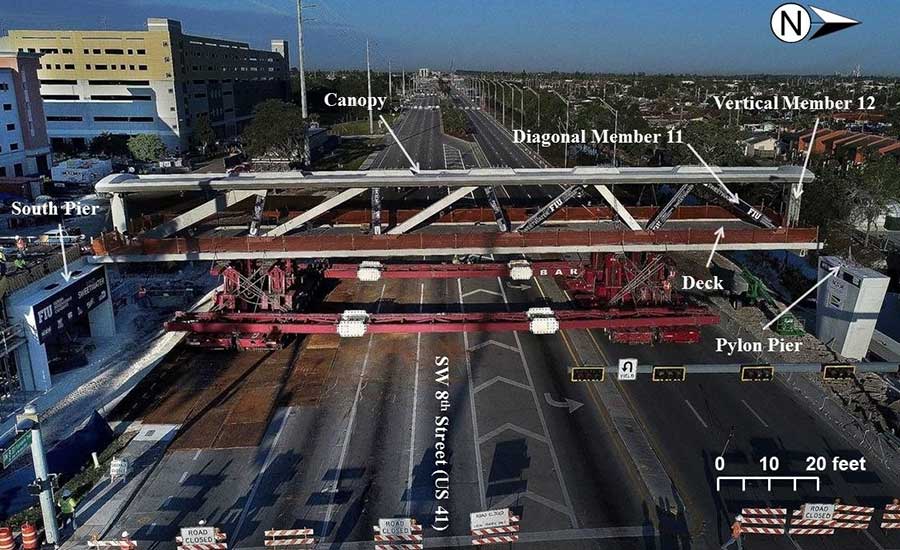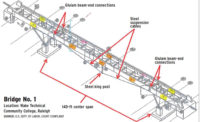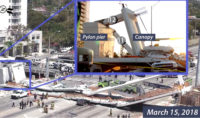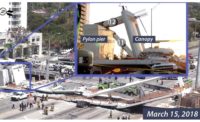Design errors may have played a role in the collapse of the 174-foot-long bridge span that was under construction at Florida International University, according to a Nov. 15 investigative update from the National Transportation Safety Board (NTSB). The structure, which was being constructed over live traffic along SW 8th Street, killed six when it suffered a sudden, catastrophic collapse on March 15.
A design review led by the Federal Highway Administration’s Office of Bridges and Structures, in support of NTSB’s investigation, determined that “errors were made in design of the northernmost nodal region of the 174-foot-long span, where two truss members were connected to the bridge deck.”
Without specifying the design errors, NTSB noted that the errors resulted in an “overestimation of the capacity (resistance) of a critical section through the node comprised of diagonal member 11 and vertical member 12,” along with an “apparent underestimation of the demand (load) on that same critical section.”
A statement from Tallahassee, Fla.-based FIGG Bridge Engineers, the project’s engineer of record, argued that the NTSB’s analysis was based on an early version of the design, and not the final one. “The update refers to the calculations on file, which were done prior to incorporating all final design comments and prior to the production of the construction plans,” the firm explained. FIGG’s statement further stresses that: “The investigative update is just that—an update on certain preliminary facts, and NTSB underscores that no probable cause conclusion should be drawn from the update.”
NTSB also reported that concrete and steel specimens tested by FHWA “met the project’s build plan’s specified minimum requirements” and that “concrete core specimens from the bridge deck and bridge canopy met the compression requirements in the project plans.”
FIU issued a statement in response to NTSB’s update, noting: “We continue to fully cooperate with the NTSB so that it may finish its investigation and complete a final report and safety recommendations. We hope the results of the investigation will help bring closure to the families and loved ones of the victims.”
Cracking Issue
The bridge section comprised by diagonal member 11 and vertical member 12 has been a focus of attention since shortly after the span fell. In a preliminary report issued in May, NTSB had noted investigators’ interest in “the propagation of cracks” near diagonal member 11 prior to the collapse. Later, an Aug. 9 update highlighted photos showing cracking in the two suspect members. At the time of the collapse, crews reportedly had been re-tensioning diagonal member 11, which was located at the structure's north end, where the failure appears to have started.
In this latest update, NTSB added that “the FHWA evaluation determined that the cracking observed in the node prior to the collapse is consistent with the identified errors.”
The agency added that the “investigation continues to examine the design, review, and construction processes as well as the actions taken once the cracking was observed.”
Researching that last point of the project team’s actions in response to the cracking would likely include examination of notes from a meeting held on-site the morning of the collapse where the design-build team, including FIGG, addressed the issue.
The Miami Herald had sued the state of Florida for release of that meeting’s records. While the Herald won in state court, a federal judge ruled in October that the documents could not be released because they were part of a federal investigation.






Post a comment to this article
Report Abusive Comment